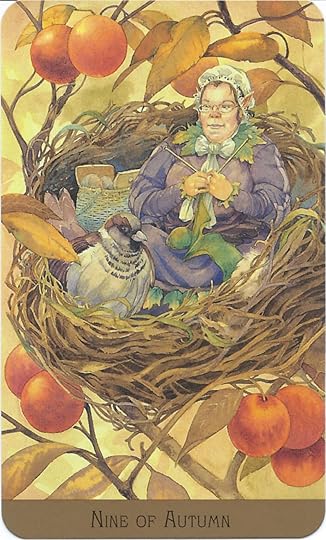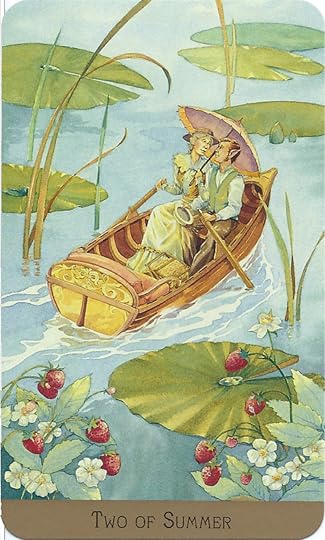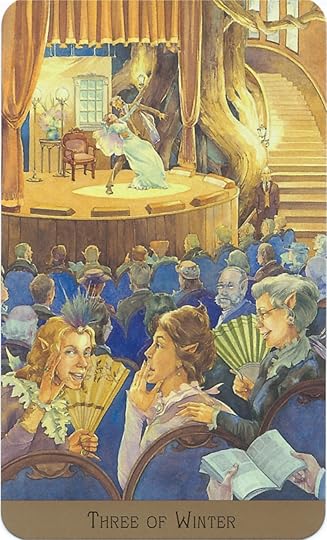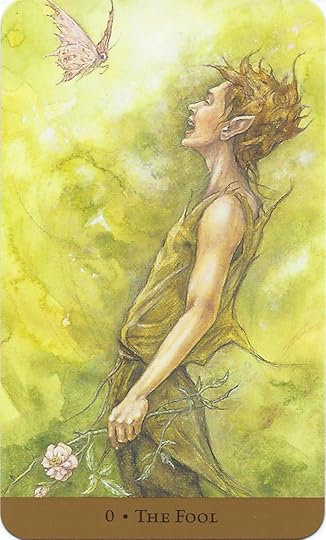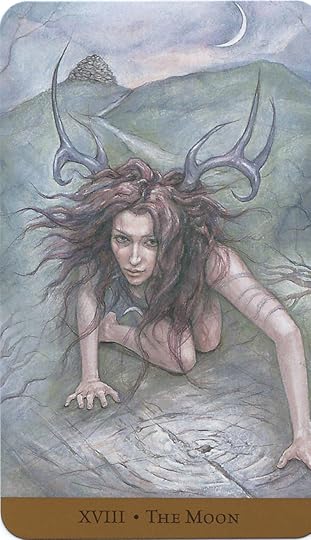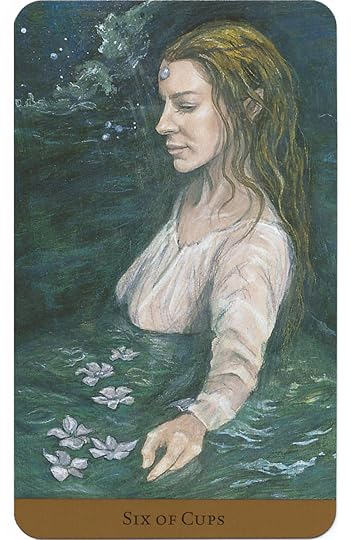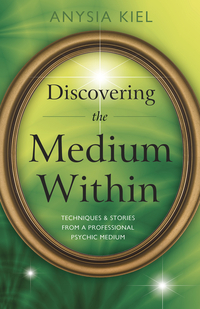Llewellyn Publications's Blog, page 79
September 17, 2013
The Anguish of Climate Change
Readers, please enjoy this guest blog post by Clea Danaan, author of the new Living Earth Devotional and Sacred Land.
If you’ve been paying attention to the current state of the planet, you may be struggling with a pervading sense of doom. Not only do all signs point to dangerous heat, crazy storms, drought, famine, fire, and pestilence—now, not in some future world of our grandchildren’s—but there is an added layer of pain for Pagans. This blessed earth, our sacred Mother, is hurting. As Pagans, we feel this pain. We cannot hide behind the idea that science will save us. It might. 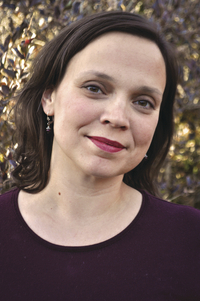 But in the meantime, our sacred earth is in turmoil. Nor can we hide behind an idea that our religion will save us. Doomsday is the end of the world. Not of spirit, perhaps, depending on your beliefs, but this beautiful, sacred, precious world. Really sitting in that knowing can overwhelm us with sharp anguish.
But in the meantime, our sacred earth is in turmoil. Nor can we hide behind an idea that our religion will save us. Doomsday is the end of the world. Not of spirit, perhaps, depending on your beliefs, but this beautiful, sacred, precious world. Really sitting in that knowing can overwhelm us with sharp anguish.
So what do we do with this pain? What are we to do when politicians play their games of money and power, as each day the planet melts and churns and rises around us? At first, we might want to crawl in a hole and give up. Throw up our hands and say, well, at least I can be a hedonist. But this attitude over a long term can lead to insanity and soul sickness. Can you feel it in your body? There is a sense of pressure and darkness when we give up. When we decide instead to commit ourselves to the task, no matter the eventual outcome—I will try, because I care so deeply—there is a sense of relaxing, surrender, peace. We give ourselves to our commitment to the sacred Earth.
So are we to never drive a car, grow and raise all of our own food, build our own composting toilet out of a bucket and sawdust, and cook that home grown food in a solar oven (stock up for those rainy days!)? Maybe. If those lifestyle choices feel right, grounded, and even fun to you. But when we are honest with ourselves, some of those choices feel just as crazy making as watching politicians repeatedly muck it up. The reason it feels just as constricting and insane is that we feel alone. We feel like the future of the whole planet is up to little old us. And that is insane.
We’re in this together. And while we can’t always affect the gyrations of Big Oil, neither do we need to go off the deep end. We need to work together as a community. We need to make the choices we can make, like leasing solar panels for our house, living closer to town so we can sell the second car, set up recycling programs and gardens at a local school, sign petitions—take on projects that inspire others, spread to new projects and communities, and give us a sense of efficacy and hope. We can also have faith in the magic of the land and sea, which can repair and renew. For example, check out The Death & Life of Monterey Bay by Stephen Palumbi and Carolyn Sotka. People who care and the power of the Earth can create healing. Sometimes it takes anguish to push us there, to places we never believed in before. When all there is to do is put one foot in front of the other, allowing the power of Life to unfold.
Our thanks to Clea for her guest post! For more from Clea Danaan, read her article “How a Devotional Practice Can Deepen Your Spirituality.”
Altars and Traditions
In major Western Ceremonial Magick traditions, the altar is described as being a “double cube.” That is, it had two equal-sized cubes on top of each other. So if your altar was to be 36″ tall, each side would be 18″. That’s the way I made my first altar. I painted it completely white (representing the spiritual light) and then decoupaged a large pentagram to the top. On one side I decoupaged a poster of the Tree of Life. I used this for many years before giving it to a temple I had been working with.
My current ceremonial magick altar is also a double cube, however it is painted black. This is to symbolize the concept that our physical universe, where I do magickal work, is spiritually dark when compared to the spiritual planes.
In most Pagan traditions I’ve been involved with the size and shape of the altar isn’t very important. Far more important are the tools you put on the altar. I’ve seen some very small Pagan altars and some enormous ones. I think the biggest altar I ever saw was at St. Peter’s in Rome. Now that’s an impressive altar:
Altar at St. Peters Basilica, Rome
I’ve seen all sorts of altars, but the one that surprised me the most was owned by a friend of mine. The feature that stood out, when I first saw it, was that it had horns in the upper corners. I had never seen an altar like that (this was some time ago), but research led to my discovery that this was the description of the altar used in the Jewish transportable tabernacle during their desert travels. In Exodus 27: 1–2, it reads:
You shall make the altar of acacia wood…
you shall make its horns on its four corners
So it probably looked a bit like this: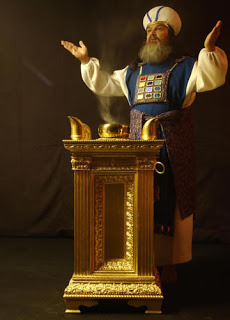
Where Did The Biblical Jews Come From?
If we assume there is some historicity behind the biblical stories, it makes sense to ask, where did the Jews come from? Or more accurately, where did the tribes who came together to become the Jews come from? The answer is right there. They were tribes in the area. Tribal members were each united to other family and people in the tribe by their own beliefs and practices as well as by their myths and stories that probably worked their way into the Bible. So it is from them that the horned altar was probably created, especially if they were a tribe that raised cattle.
Today, we’re learning more and more about these ancient peoples and their beliefs. So if you’re interested in this topic, I’ll like to recommend the book, The Horned Altar by Tess Dawson. 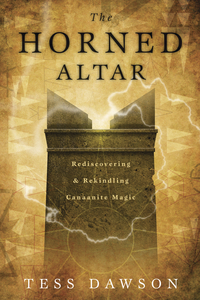
In this book, Ms. Dawson reveals the secrets of the ancient Canaanite religion. You’ll learn what they believed and how they practiced. You’ll be able to incorporate some of their beliefs into your spiritual path or maybe adopt Canaanite religion as your path. Well researched, I think this is an important addition to our knowledge of the practices and beliefs of our ancestors.
* * *
This coming Sunday, September 22, 2013, at 10:00 p.m. Central Time (8:00 Pacific) I’m going to be interviewed on Pagan Science Radio. You can go to this LINK (it will take you to the blogtalkradio site) and listen in live. We’re going to be talking about a wide range of subjects ranging from Tarot & Magic to hypnosis and NLP. I may even share an introduction to smoking cessation that beings with…explosive cow flatulence! This should be a lot of fun and I hope you can listen in and say hello! Pagan Science Radio
The Truth or Something Else
For most of my journey with tarot, I always assumed the that the cards told us the truth. As a reader who does predictive readings, I know one of the reasons people often don’t predict is that the future isn’t written in stone and that things can change, by our own actions and those of others. I also know that we can be wrong.
Putting those things aside for a moment, just for the sake of discussion, I wonder if the Divine (through tarot or any other divination method) doesn’t always or even ever tell us the truth. Maybe it tells us what we need to hear, for whatever in fathomable reasons. Using a very concrete and simplistic example, what if someone asks if they will ever get back together with their boyfriend and the cards say very clearly that no, getting back together isn’t really a probability. So the querent goes on, living her life, moving on, healing, all of that sort of thing. Then they do get back together.
I suppose then we could say, well, by her actions of getting on with her life and healing, she changed the future and created circumstances whereby they did reunite. But if the cards don’t indicate “if you do x, y, and z, you will get back together,” then did the cards tell the only part of the truth? If the cards told the “whole” truth, maybe she wouldn’t have healed and moved on in an authentic way but in a surface way, a kind of biding her time kind of way. Then they probably wouldn’t have gotten back together.
Do you see what I mean? This question has been rattling around in my head for a while now. I’d love to know what you think. Does the tarot always tell the complete truth or does it tell what we need to know, and I suppose by extension, believe, even if it isn’t “true”?
September 16, 2013
Question Authority: The Hierophant and the Vicar
Readers, please enjoy this guest blog post by Lunaea Weatherstone, creator of a number of tarot decks, including the new Victorian Fairy Tarot.
The Hierophant is a card that doesn’t seem to get much love from the tarot community. We are a free-thinking bunch, generally speaking, and the Hierophant is often interpreted as being rigid, dogmatic, and spiritually constraining. The Rider-Waite-Smith card shows a throned Pope making a blessing gesture as two tonsured initiates kneel before him. The initiates are clearly in a less-powerful position, and traditionally this card can mean a surrender of spiritual free will to a higher authority.
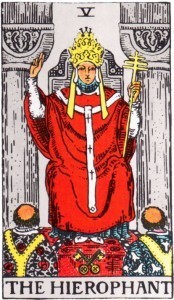 I’m actually rather fond of the Hierophant for a couple of reasons. First, I have always been drawn to the idea of spiritual vocation, so a card that pictures three people who have all chosen to offer themselves in devotional service to their deity is an appealing one. Second, I see this card as having the potential to represent what the Benedictine monk Brother David Steindl-Rast calls, “true and legitimate authority.” This is authority in the sense of “He is an authority on ancient Egyptian art.” It implies scholarly learning as well as real-world application of that learning. When you are in the presence of true authority, you don’t feel put down or constricted. True authority will always welcome questioning and discussion of ideas, for that is how we best learn and deepen in wisdom.
I’m actually rather fond of the Hierophant for a couple of reasons. First, I have always been drawn to the idea of spiritual vocation, so a card that pictures three people who have all chosen to offer themselves in devotional service to their deity is an appealing one. Second, I see this card as having the potential to represent what the Benedictine monk Brother David Steindl-Rast calls, “true and legitimate authority.” This is authority in the sense of “He is an authority on ancient Egyptian art.” It implies scholarly learning as well as real-world application of that learning. When you are in the presence of true authority, you don’t feel put down or constricted. True authority will always welcome questioning and discussion of ideas, for that is how we best learn and deepen in wisdom.
Brother David says: “The true and legitimate authority builds you up, augments your knowing, augments your ability to act rightly. It raises you up, increases your self-confidence, empowers you. Therefore, the great responsibility of everyone is to question authority. I am talking about a respectful, honest, straightforward questioning of authority. That is our duty, not just our privilege. That’s what keeps authority on the right track.” (From an interview in Tricycle magazine, Fall 1991)

When it came time to depict the Hierophant card for my Victorian Fairy Tarot (illustrated by Gary A. Lippincott), I wanted to show this idea of legitimate and—above all—approachable spiritual authority. My version shows a kindly fairy Vicar seated on the roots of an oak tree and speaking to members of his congregation. He shares his teachings with humility, respect, and love, which the grateful fairies return to him tenfold. The Vicar welcomes lively discussion and dialogue, and his gatherings often ring with the sound of merry laughter.
The word hierophant comes from the Greek hieros (sacred) and phainein (show). Without the need to control or condemn, the Vicar shows the sacred by example as well as by teaching. Nestled among the roots of the great tree of wisdom, the fairies can safely open their hearts as well as their minds.
Our thanks to Lunaea for her guest post! For more on the Victorian Fairy Tarot, browse the cards.
September 13, 2013
See Me and Other Llewellyn Authors In Person and Online
As I wrote at the end of my previous post,
This coming Saturday, September the 14th, I’ll be giving a workshop for the San Diego Pagan Pride day event. This family friendly (and dog friendly!) day will be held from 9:00 am to 5:00 pm at 6th and El Prado/Laurel in beautiful Balboa Park. If you haven’t attended in the past, come on out to hear me give a workshop at 11:00 am. There will also be other workshop presenters, live music, rituals, and vendors. The event is free, but please bring some non-perishable foods as a donation for Mama’s Kitchen, a volunteer-driven, nonprofit organization that prepares and delivers food to men, women and children who are affected by AIDS or cancer.
Indeed, I have a lot of appearances coming up, both in-person and over the internet. You can see where I’ll be and what I’m doing via this LINK. Most authors will have web pages or Facebook pages listing where they’ll be, too. For me, appearances this year are later than last year, but I’ll be available in more places and to more people, so that’s a good thing. I hope you’ll come to see me and some of the other excellent speakers (many of whom are Llewellyn authors) either online or in person.
Recently I received an email from a young woman whom I hadn’t heard from in many years. It had several statements saying how wonderful she thought I was, and I thought that was very kind and I was extremely flattered. This made me think of how she thought of me and of how we all react to our teachers. Respect, honor, and admiration are one thing, but thinking of them as being perfect and only capable of uttering the truth worries me. In fact, over 2.5 years ago I made a post with comments I still think are valid. Here is what I wrote:
TFYQA
Whenever I give workshops, I begin by writing the letters TFYQA on a blackboard. Well, actually I now have my computer write them on a screen or blank wall, but you get the idea.
The letters stand for “Think For Yourself. Question Authority.” I explain that neither I (nor other speakers at various metaphysical events) are lying or trying to deceive. Rather, we’re doing our best to explain some complex material. Sometimes it will be clear and make sense. Other times the approach of the teachers just doesn’t do it for you.
From Slide Presentations
That’s all okay. I suggest that people pay attention and try out what the lecturers have to share. “If it works, that’s great, because now you have new ideas, approaches or skills that you can use. And if it doesn’t work, that’s great, too, because now you know what you don’t have to waste your time with.”
In my opinion, the same is true of books. Books are written with ink on paper (or electrons on your screen). They are not written in stone. Read books. Read lots of them. Study what the writers have to say and practice any techniques.
Remember, however, that occultists are at the vanguard of the New Age, they are helping drive civilization into the Age of Aquarius. In this new age, instead of blindly following leaders, we will each become our own leader. There’s no reason we shouldn’t act that way now.
Recently, a person emailed me thanking me for Modern Magick. He wrote that he had studied it for years, he still recommends it, but he strongly disagrees with parts of it (he didn’t tell me which parts). I think he may have been trying to get a rise out of me and probably didn’t expect my response. I replied, “I’m glad that you disagree with parts of MM–it shows that you’re a thinker rather than a follower. That’s a good thing!”
I don’t care who the writer is. If you simply say, “Yes, I agree with everything this writer had put into books,” chances are you’re stuck in the Old Age, the Piscean Age. There are occult writers I deeply respect, but I don’t agree with everything they have published. I know some people who idolize Aleister Crowley and fawn over everything he wrote. And yet Crowley himself (at the beginning of Magic in Theory and Practice, as I recall) wrote that other teachers tell you what to think while he asks you to think.
I would agree and would ask you to think, too. Listen to speakers. Read books. Try out what they suggest. But then, come up with your own ideas. If some ideas and practices work for you, adopt them and adapt them. If some ideas and practices don’t work for you, abandon them. Dion Fortune wrote that there is no room for authority in occultism. Or perhaps more accurately, in the New Age, the only authority when it comes to your occult and magickal practices is you.
THINK FOR YOURSELF. QUESTION AUTHORITY.
September 12, 2013
Victorian Fairies are here!
I know many of you have been waiting for this lovely deck and it is finally here! And you can see more HERE.
I also know that sometimes people are disappointed in a long-awaited deck for various reasons. One is that sometimes it feels like the Minors were given short shrift and lack the detail and richness of the Majors. That is definitely not the case with this deck. Every card is like a peek into a richly and fully formed scene. Here are some of my favorites:
September 10, 2013
The Hidden Realm
Julia Jeffrey’s Tarot of the Hidden Realm is an incredibly emotional and evocative deck. Working with her on it and in particular writing the book and finding the voice of these cards was an adventure. Because of the nature of the art, which felt deeply elemental and shamanic, I used shamanic journeying techniques for some of the images. My intent was to journey for each and every card, but some of the journeys were quite exhausting, so I only did some of them that way.
I wanted to share a range of images here, from incredibly intense to very calm, so you can get a sense of the depth of feeling Julia portrays.
September 9, 2013
The Fear that Paralyzes
Many months ago I turned in a manuscript to Llewellyn for consideration. I had been working on this manuscript for many years, and I had followed the formatting rules I had thought were appropriate for the submission.
I thought wrong.
I also received a large number of suggestions from my acquisition editor.
I spent a lot of time considering what I would do. I came to realize that as an author, it’s important to understand that what you create is a product, not a baby. In my opinion the goal of the author in writing a book (excluding those that are simply written for a profit) is to be able to share your ideas and concepts with as many readers as possible.
The challenge to this is that we spend months or years creating our manuscript. We think about it. We dream about it. We live it. And then somebody tells us that to reach the greatest number of people—that is, to achieve our actual goal—we need to make changes. How dare they!? How dare they want changes to the baby that grew in my heart and soul for so long!?
But it’s not a baby, it’s a product. It’s a product of our hearts, minds, and spirits, but it’s a product nonetheless. And oftentimes, writers literally become too close to a project and need some objective clarity to turn their baby back into a product that a publisher can produce and readers will want to read.
So I’ve been re-doing a lot of my new manuscript. I’ve completely reformatted it. I’ve rearranged some of the content and deleted some material that, as I objectively look at it, wasn’t necessary. I’m in the process of turning what I had thought was my perfect baby into what I believe and know will be a great manuscript.
So over the weekend I used my tabletop studio to take more high-definition pictures for the manuscript. I still have to edit them, but at this point I have only two more photos to take. My project, after so long, is coming to fruition. It’s coming to an end.
And I ended up having an odd feeling, a sensation that I hadn’t experienced in quite some time. I could see and feel that the successful end of my work was at hand. It was almost finished. I felt empty.
Many people experience this. It’s not about the completion of a project. Rather, it’s a fear of success. Some people never finish writing a book or a painting they started. Some people don’t finish their college degrees. Unconsciously they know that success marks the end of one phase in their lives and they don’t know where the next phase will lead. It’s a fear of the unknown. And it is this fear that paralyzes many people, preventing them from finishing what they started.
Even though I have more work to do before I can re-submit my improved manuscript, I realized I needed to get past the paralysis of success/completion and the accompanying fear of an unknown future. So I hopped on the metaphoric horse and started writing my next book. I don’t think it will take anywhere near as long as the manuscript I’m finishing. I’m excited about them both.
Are you paralyzed by a fear of success? Have you gotten past it, finished a project, a moved on? How did you do it? You can share your ideas in the comments section below.
What About Your Baby?
Do you have a baby—an occult non-fiction manuscript—you haven’t finished? As acquisition editor, I’d like to have the opportunity to consider your manuscript for publication, even if it’s not finished. Even if you’ve worked on it for a long time and not finished it. Perhaps I can make some suggestions to help you finish and move into a new and wonderful phase in your life, a phase you can excitedly enter rather than fearfully avoid. Please send your questions and ideas to me. My email is [email protected]
Pagan Pride San Diego
This coming Saturday, September the 14th, I’ll be giving a workshop for the San Diego Pagan Pride day event. This family friendly (and dog friendly!) day will be held from 9:00 am to 5:00 pm at 6th and El Prado/Laurel in beautiful Balboa Park. If you haven’t attended in the past, come on out to hear me give a workshop at 11:00 am. There will also be other workshop presenters, musical and dance presentations, rituals, and vendors. The event is free, but please bring some non-perishable foods as a donation for Mama’s Kitchen, a volunteer-driven, nonprofit organization that prepares and delivers food to men, women and children who are affected by AIDS or cancer.
Besides my workshop, I’ll be signing my books. You can bring your copies or get them from me there. Also, I’m on the hunt for more writers. If you have a manuscript or even just an idea for a manuscript, let me know! Let’s talk.
Discovering the Medium Within Wins Living Now Book Award
We are excited to announce that Discovering the Medium Within by Anysia Kiel has won the Gold Medal in the “Metaphysical” category of the 5th annual Living Now Book Awards.
The Living Now Book Awards are designed to bring increased recognition to the year’s very best lifestyle books and their creators, and celebrate the innovation and creativity of newly published books that can help us improve the quality of our lives, from cooking and entertaining to fitness and travel.
Congratulations!
September 6, 2013
Can You See Me Now?
Over a year ago I made a post where I shared this story about Aleister Crowley:
There is a story of a young man, sitting in a café (I’ve heard of different locations where this story occurred), when all of a sudden, a strange man, dressed in yellow, comes darting through the café, babbling in a strange, foreign language. To his surprise, nobody was paying any attention to this obviously crazy man. The shocked café-goer asks the head waiter if something should be done. The head waiter replies, “Oh no, sir. That’s just Mr. Crowley being invisible again.”
Like him or hate him, there are many things you can say about Crowley. Claiming he was an idiot is not one of them.
Assuming this story is true, does anyone think Crowley was so dumb that he thought he had turned himself transparent? I don’t. And yet, the story continues that when he came back and talked with some of his followers, he told them that to the people in the café he must have been invisible. After all, if you saw someone dressed in yellow robes running around and babbling, wouldn’t you say something about it? I would. And yet, no one there did. Therefore, Crowley assumed he had achieved invisibility.
Invisibility ≠ Transparency
Today, most people think the ability to become invisible would mean that people could see right through you, that you would become perfectly see-through. In H.G. Wells famous book from 1897, The Invisible Man, as well as in James Whale’s classic 1933 movie of the same name staring Claude Rains, a principle aspect is not how amazing being invisible would be, but rather, how difficult and even disgusting being transparent is. First, you’d have to run around naked, and if it were too hot or cold you’d suffer. You’d easily be seen in fog, rain, or snow. And since you had to eat, you would end up having to hide while the digestive system slowly—and visually disgustingly—breaks down the food. Only when it was assimilated could you go out naked again. There are just too many problems being transparent to make it useful. Harry Potter’s “Invisibility Cloak” is just a bad idea.
But it’s bad only if you equate invisibility with transparency. If you return to the original concept of the term invisibility as “the inability to be seen,” we can have a very practical magickal tool. In my book, Modern Magick, I describe the concept of using the Rose Cross ritual to draw your aura toward your spine, making it smaller and smaller. By doing this your aura doesn’t come in contact with that of others, so unless someone is specifically looking for you, you won’t be noticed.
You may have experienced something like this accidentally. Feeling down and depressed tends to bring your aura inward. Perhaps, while feeling this way, you decided to go to a party and cheer yourself up. Unfortunately, it didn’t work. The next day, a friend calls you and tells you about the wonderful time she had at the party, saying, “You should have been there.” When you tell her you were there, she responds, “That couldn’t be so. I’d have seen you.” And yet, she didn’t. You were right there but even your friends didn’t see you. For all practical purposes you were invisible.
So I guess you have to ask yourself which is more important to you: becoming transparent or becoming invisible and having nobody realize you’re there. While the former is leading to interesting scientific research, on a practical level for today, it is the latter that is valuable. For invisibility, it’s more important that people don’t see you, not that you physically fade away.
Becoming invisible this way sounds as shamanic as shape shifting. And yet, The Hermetic Order of the Golden Dawn, a group dedicated to ceremonial magick, has elaborate instructions on how to achieve this goal. The technique is given beginning on page 387 of Israel Regardie‘s book, The Golden Dawn, where it’s called, “The Shroud of Concealment.”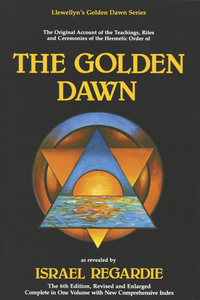
Guard the Mysteries—Reveal them Constantly
Many years ago, the New York store known as Magickal Childe, owned by the late Herman Slater, published a magazine titled “Earth Religions News.” The motto of the magazine was “Guard the Mysteries; Reveal them Constantly.” That has always impressed me. One of the best ways to guard magickal secrets is to reveal them. If a person isn’t ready to understand and use them, the student will be unable to put the secrets to practical use. Therefore, one of the best ways to guard magickal secrets is to simply reveal them. People with the knowledge and skill to use them will be able to do so. They’ll keep the mysteries alive. Those who can’t make use of the information will ignore it or make fun of it. It’s an odd reversal, but by revealing secrets you keep them available to those who can use them and ignored by those who cannot.
The Shroud of Concealment is not a long or complex rite. Regardie shares the entire rite in less than two pages. I could publish it here, but that would just be a way to guard the mysteries by revealing them. You see, the ritual is based on a complete understanding of the Order’s Neophyte initiation ritual and how to work with all of the energies within that ritual. Most people, looking at an initiation rite, think that’s all there is to it. However, each of the initiation rites of the Golden Dawn Order form the outline for the creation of powerful and practical magical rituals. As MacGregor Mathers, co-founder of the original Golden Dawn wrote,
In the true knowledge of the application of the symbolism of the “Enterer” [the Neophyte Initiation Ritual] lies the entrance to the knowledge of Practical Magic: and therefore all the Formulae drawn from the Ritual classed under Five several heads [the five general types of magick performed by Golden Dawn members], according to the Letters of the name Yeheshuah.
So to be able to effectively use the ritual for invisibility requires knowledge and ability that requires a minimum of about two years of training and practice.
I’m not trying to hide anything here. You can go into any bookstore and turn to the page in The Golden Dawn and read the ritual for yourself. But without practical knowledge of the previous material of the Golden Dawn tradition, it won’t make much sense. And as Eliphas Levi wrote, “Telling the truth to someone who can’t understand it is tantamount to telling that person a lie.”
For example, instruction part “R” states, “Still formulating the shroud, say, ‘Before all Magical manifestation cometh the knowledge of the hidden light.’ Then move to the pillars and give the signs and steps, words, etc…” And in step “W”: “Having obtained the desired effect, and gone about invisible, it is required that thou shouldst conjure the Powers of the Light to act against that shroud of Darkness and Mystery so as to disintegrate it, lest any force seek to use it as a medium for an obsession, etc.” If you’re familiar with the Golden Dawn tradition and are skilled in the Order’s techniques, doing this rite is almost simple. Without that knowledge and skill, however, you won’t accomplish a thing.
So invisibility—not transparency—is absolutely possible. However, it takes preparation and work. If there is no group around you that can guide you, I would respectfully suggest working through Modern Magick and then working through The Golden Dawn so you can obtain this ability. Why? Well, this virtual form of invisibility is a cool ability to have. Plus, as it says in the ritual, the result of doing this successfully is also “…a certain Divine Exstasis and an exaltation desirable, for herein is a sensation of an exalted strength.”
Contest is Still On!
Win a Free Tarot Deck!
That’s right. You can win a free Tarot deck simply by proving yourself to be the best predictor of the future. The contest is simple. The winner of the free Tarot deck is the person who makes the earliest and most accurate and specific prediction. To enter, and to read the full details on this contest, click on this LINK.
Llewellyn Publications's Blog
- Llewellyn Publications's profile
- 241 followers



